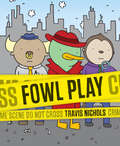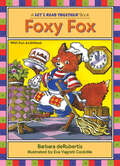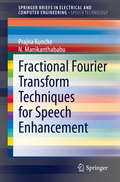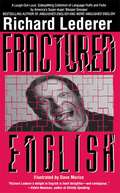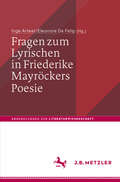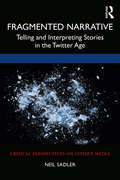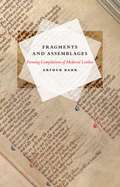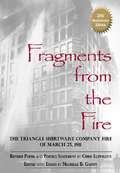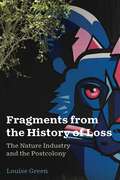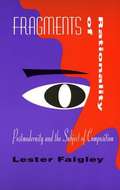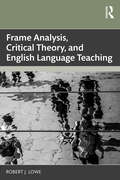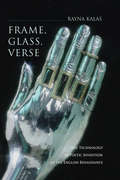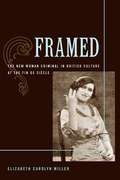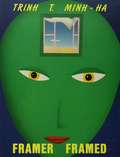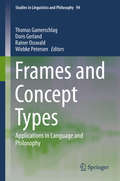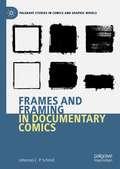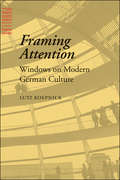- Table View
- List View
Fowl Play: A Mystery Told in Idioms!
by Travis NicholsMeet the Gumshoe Zoo detectives! &“This enjoyable introduction to idiomatic speech gives lots of laughs, a mystery to solve, and a funny cliff-hanger.&” —School Library Journal Just what kind of monkey business has befallen Mr. Hound&’s shop? Luckily, our team of plucky detectives has been chomping at the bit to take on their first case. When Mr. Hound hires them to investigate, they hoof it to his shop. And once they get sleuthing, wild horses couldn&’t drag them away from the scent of a clue. But is it all just a dog and pony show to distract them from the truth? Idioms are everywhere in this hilarious first case of the Gumshoe Zoo detective agency as they attempt to solve Mr. Hound&’s mystery. Early readers will love the multi-paneled comic book hybrid feel of this raucous adventure as the detectives manage to keep a straight face, collar some suspects, and solve a mystery, all while avoiding beating a dead—never mind. &“Nichols goes hog wild in a goofball detective story bursting with animal-themes idioms . . . A highly entertaining comic mystery.&” —Publishers Weekly &“Idioms get a run for their money in this good-humored and stimulating piece of wordplay from Nichols . . . Amusing to the point of provoking an inquiry. Really, it&’s the bee&’s knees.&” —Kirkus Reviews &“Give this to a kid who enjoys puzzles and witty turns of phrase.&” —Shelf Awareness &“Packed with learning and gobs of fun.&” —Books to Borrow, Books to Buy &“An awesome book to teach the differences between the literal and the figurative.&” —Books and Whatnot
Foxy Fox: Short Vowel O (Let's Read Together ®)
by Barbara deRubertisLet&’s Read Together books merge rhyme and vowel sounds in delightfully zany stories kids will want to read again and again. Each of the 15 books in this classic series by award-winning author/educator Barbara deRubertis will give your child a jumpstart on reading success."Story lines are silly and inventive, and recall Dr. Seuss&’s Cat in the Hat for the building of rhythm and rhyming words." —School Library JournalFoxy Fox drops the pot and slops the mop. Will he lose his job at Mom and Po's shop? (This easy-to-read story features the short &“o&” vowel sound.)
Fractional Fourier Transform Techniques for Speech Enhancement (SpringerBriefs in Speech Technology)
by Prajna Kunche N. ManikanthababuThis book explains speech enhancement in the Fractional Fourier Transform (FRFT) domain and investigates the use of different FRFT algorithms in both single channel and multi-channel enhancement systems, which has proven to be an ideal time frequency analysis tool in many speech signal processing applications. The authors discuss the complexities involved in the highly non- stationary signal processing and the concepts of FRFT for speech enhancement applications. The book explains the fundamentals of FRFT as well as its implementation in speech enhancement. Theories of different FRFT methods are also discussed. The book lets readers understand the new fractional domains to prepare them to develop new algorithms. A comprehensive literature survey regarding the topic is also made available to the reader.
Fracture Feminism: The Politics of Impossible Time in British Romanticism (SUNY series, Studies in the Long Nineteenth Century)
by David SiglerFeminist writers in British Romanticism often developed alternatives to linear time. Viewing time as a system of social control, writers like Mary Wollstonecraft, Anna Barbauld, and Mary Shelley wrote about current events as if they possessed knowledge from the future. Fracture Feminism explores this tradition with a perspective informed by Lacanian psychoanalysis and Derridean deconstruction, showing how time can be imagined to contain a hidden fracture—and how that fracture, when claimed as a point of view, could be the basis for an emancipatory politics. Arguing that the period's most radical experiments in undoing time stemmed from the era's discourses of gender and women's rights, Fracture Feminism asks: to what extent could women "belong" to their historical moment, given their political and social marginalization? How would voices from the future interrupt the ordinary procedures of political debate? What if utopia were understood as a time rather than a place, and its time were already inside the present?
Fracture and Fragmentation in British Romanticism
by Alexander RegierWhat associates fragmentation with Romanticism? In this book, Alexander Regier explains how fracture and fragmentation form a lens through which some central concerns of Romanticism can be analysed in a particularly effective way. These categories also supply a critical framework for a discussion of fundamental issues concerning language and thought in the period. Over the course of the volume, Regier discusses fracture and fragmentation thematically and structurally, offering new readings of Wordsworth, Kant, Burke, Keats, and De Quincey, as well as analysing central intellectual presuppositions of the period. He also highlights Romanticism's importance for contemporary scholarship, especially in the writings of Benjamin and de Man. More generally, Regier's discussion of fragmentation exposes a philosophical problem that lies behind the definition of Romanticism.
Fragen zum Lyrischen in Friederike Mayröckers Poesie (Abhandlungen zur Literaturwissenschaft)
by Inge Arteel Eleonore De FelipFriederike Mayröcker zählt zu den herausragenden lyrischen Stimmen der Gegenwart. Der vorliegende Band bietet Annäherungen an ihr lyrisches Werk. Entstanden im Laufe von mehr als 70 Schaffensjahren, spiegelt es die Entwicklung einer Einzelgängerin von ihren Anfängen in den letzten Kriegsjahren durch die Zeit der formalen Experimente in den 1960er und 1970er Jahren bis hin zu ihrem sogenannten Spätwerk. Mayröckers Poetik zeichnet sich durch ein komplexes System an intertextuellen und -medialen Bezügen, an Fremd- und Selbstzitaten, an motivischen Fortführungen und Variationen aus. Zugleich entziehen sich ihre Gedichte der interpretativen Entschlüsselung und Fixierung. - Durch innovative Perspektivierungen und neue Erkenntnisse kommen die hier versammelten Analysen der sprachlichen Kraft, formalen Kühnheit und emotionalen Tiefe von Mayröckers Gedichten auf die Spur. Die Beiträge widmen sich insbesondere Mayröckers jüngsten Bänden, ihrem Dialog mit Hölderlin sowie auch grundsätzlichen lyrikologischen Fragestellungen.
Fragile Minds and Vulnerable Souls: The Matter of Obscenity in Nineteenth-Century Germany (Material Texts)
by Sarah L. LeonardFragile Minds and Vulnerable Souls investigates the creation of "obscene writings and images" as a category of print in nineteenth-century Germany. Sarah L. Leonard charts the process through which texts of many kinds—from popular medical works to stereoscope cards—were deemed dangerous to the intellectual and emotional lives of vulnerable consumers. She shows that these definitions often hinged as much on the content of texts as on their perceived capacity to distort the intellect and inflame the imagination.Leonard tracks the legal and mercantile channels through which sexually explicit material traveled as Prussian expansion opened new routes for the movement of culture and ideas. Official conceptions of obscenity were forged through a heterogeneous body of laws, police ordinances, and expert commentary. Many texts acquired the stigma of immorality because they served nonelite readers and passed through suspect spaces; books and pamphlets sold by peddlers or borrowed from fly-by-night lending libraries were deemed particularly dangerous. Early on, teachers and theologians warned against the effects of these materials on the mind and soul; in the latter half of the century, as the study of inner life was increasingly medicalized, physicians became the leading experts on the detrimental side effects of the obscene. In Fragile Minds and Vulnerable Souls, Leonard shows how distinctly German legal and medical traditions of theorizing obscenity gave rise to a new understanding about the mind and soul that endured into the next century.
Fragmented Narrative: Telling and Interpreting Stories in the Twitter Age (Critical Perspectives on Citizen Media)
by Neil SadlerWith the rise and rise of social media, today’s communication practices are significantly different from those of even the recent past. A key change has been a shift to very small units, exemplified by Twitter and its strict 240-character limit on individual posts. Consequently, highly fragmented communication has become the norm in many contexts. Fragmented Narrative sets out to explore the production and reception of fragmentary stories, analysing the Twitter-based narrative practices of Donald Trump, the Spanish political movement Podemos, and Egyptian activists writing in the context of the 2013 military intervention in Egypt. Sadler draws on narrative theory and hermeneutics to argue that narrative remains a vital means for understanding, allowing fragmentary content to be grasped together as part of significant wholes. Using Heideggerian ontology, he proposes that our capacity to do this is grounded in the centrality of narrative to human existence itself. The book strives to provide a new way of thinking about the interpretation of fragmentary information, applicable both to social media and beyond. Contributing to the emerging literature in existential media studies, this timely volume will interest students, scholars and researchers of narrative, new media and language and communication studies.
Fragments and Assemblages: Forming Compilations of Medieval London
by Arthur BahrIn Fragments and Assemblages, Arthur Bahr expands the ways in which we interpret medieval manuscripts, examining the formal characteristics of both physical manuscripts and literary works. Specifically, Bahr argues that manuscript compilations from fourteenth-century London reward interpretation as both assemblages and fragments: as meaningfully constructed objects whose forms and textual contents shed light on the city's literary, social, and political cultures, but also as artifacts whose physical fragmentation invites forms of literary criticism that were unintended by their medieval makers. Such compilations are not simply repositories of data to be used for the reconstruction of the distant past; their physical forms reward literary and aesthetic analysis in their own right. The compilations analyzed reflect the full vibrancy of fourteenth-century London's literary cultures: the multilingual codices of Edwardian civil servant Andrew Horn and Ricardian poet John Gower, the famous Auchinleck manuscript of texts in Middle English, and Chaucer's Canterbury Tales. By reading these compilations as both formal shapes and historical occurrences, Bahr uncovers neglected literary histories specific to the time and place of their production. The book offers a less empiricist way of interpreting the relationship between textual and physical form that will be of interest to a wide range of literary critics and manuscript scholars.
Fragments and Assemblages: Forming Compilations of Medieval London
by Arthur BahrIn Fragments and Assemblages, Arthur Bahr expands the ways in which we interpret medieval manuscripts, examining the formal characteristics of both physical manuscripts and literary works. Specifically, Bahr argues that manuscript compilations from fourteenth-century London reward interpretation as both assemblages and fragments: as meaningfully constructed objects whose forms and textual contents shed light on the city’s literary, social, and political cultures, but also as artifacts whose physical fragmentation invites forms of literary criticism that were unintended by their medieval makers. Such compilations are not simply repositories of data to be used for the reconstruction of the distant past; their physical forms reward literary and aesthetic analysis in their own right. The compilations analyzed reflect the full vibrancy of fourteenth-century London’s literary cultures: the multilingual codices of Edwardian civil servant Andrew Horn and Ricardian poet John Gower, the famous Auchinleck manuscript of texts in Middle English, and Chaucer’s Canterbury Tales. By reading these compilations as both formal shapes and historical occurrences, Bahr uncovers neglected literary histories specific to the time and place of their production. The book offers a less empiricist way of interpreting the relationship between textual and physical form that will be of interest to a wide range of literary critics and manuscript scholars.
Fragments from the Fire: The Triangle Shirtwaist Company Fire of March 25, 1911
by Chris Llewellyn Michelle GaffeyThe Triangle Shirtwaist Company manufactured blouses for women and was located on the eighth, ninth, and tenth floors of the Asch Building, at the corner of Washington Place and Greene Street, in New York City's Washington Square.The company employed up to 900 workers at a time, but on March 25, 1911, only about 500 were present. These were immigrants, most of whom could not speak the English language. Nearly all were female, primarily Russian or Italian, although twelve nationalities were known to be ''on the books.'' At about 4:45 p.m., just after pay envelopes had been distributed, a fire broke out. Not everyone was able to reach the elevators and stairways. On the ninth floor, because the bosses had kept the doors locked to keep out union organizers, workers were forced to jump from windows. One hundred forty-six people, some as young as fourteen, perished. In 1987, Chris Llewellyn chronicled the Triangle Fire and its aftermath in her award-winning, polyvocal book of poems, Fragments from the Fire. Now, 105 years after the Fire, Fragments is in print once again. With poetic and documentary impulses, Fragments speaks to the deplorable working conditions that characterize the garment industry in this new millennium as it continues to commemorate the Triangle Fire of March 25, 1911. Winner of the Walt Whitman Award for 1986, this is a revised 30th anniversary edition of that book which was originally published by Viking Press in 1987 and again in "Steam Dummy & Fragments from the Fire" by Bottom Dog Press in 1993.
Fragments from the History of Loss: The Nature Industry and the Postcolony (AnthropoScene)
by Louise GreenThe Anthropocene’s urgent message about imminent disaster invites us to forget about history and to focus on the present as it careens into an unthinkable future. To counter this, Louise Green engages with the theoretical framing of nature in concepts such as the “Anthropocene,” “the great acceleration,” and “rewilding” in order to explore what the philosophy of nature in the era of climate change might look like from postcolonial Africa.Utilizing a practice of reading developed in the Frankfurt school, Green rearranges narrative fragments from the “global nature industry,” which subjugates all aspects of nature to the logic of capitalist production, in order to disrupt preconceived notions and habitual ways of thinking about how we inhabit the Anthropocene. Examining climate change through the details of everyday life, particularly the history of conspicuous consumption and the exploitation of Africa, she surfaces the myths and fantasies that have brought the world to its current ecological crisis and that continue to shape the narratives through which it is understood. Beginning with African rainforest exhibits in New York and Cornwall, Green discusses how these representations of the climate catastrophe fail to acknowledge the unequal pace at which humans consume and continue to replicate imperial narratives about Africa. Examining this history and climate change through the lens of South Africa’s entry into capitalist modernity, Green argues that the Anthropocene redirects attention away from the real problem, which is not human’s relation with nature, but people’s relations with each other.A sophisticated, carefully argued call to rethink how we approach relationships between and among humans and the world in which we live, Fragments from the History of Loss is a challenge to both the current era and the scholarly conversation about the Anthropocene.
Fragments from the History of Loss: The Nature Industry and the Postcolony (AnthropoScene: The SLSA Book Series #5)
by Louise GreenThe Anthropocene’s urgent message about imminent disaster invites us to forget about history and to focus on the present as it careens into an unthinkable future. To counter this, Louise Green engages with the theoretical framing of nature in concepts such as the "Anthropocene," "the great acceleration," and "rewilding" in order to explore what the philosophy of nature in the era of climate change might look like from postcolonial Africa.Utilizing a practice of reading developed in the Frankfurt school, Green rearranges narrative fragments from the "global nature industry," which subjugates all aspects of nature to the logic of capitalist production, in order to disrupt preconceived notions and habitual ways of thinking about how we inhabit the Anthropocene. Examining climate change through the details of everyday life, particularly the history of conspicuous consumption and the exploitation of Africa, she surfaces the myths and fantasies that have brought the world to its current ecological crisis and that continue to shape the narratives through which it is understood. Beginning with African rainforest exhibits in New York and Cornwall, Green discusses how these representations of the climate catastrophe fail to acknowledge the unequal pace at which humans consume and continue to replicate imperial narratives about Africa. Examining this history and climate change through the lens of South Africa’s entry into capitalist modernity, Green argues that the Anthropocene redirects attention away from the real problem, which is not human’s relation with nature, but people’s relations with each other.A sophisticated, carefully argued call to rethink how we approach relationships between and among humans and the world in which we live, Fragments from the History of Loss is a challenge to both the current era and the scholarly conversation about the Anthropocene.
Fragments of Rationality: Postmodernity and the Subject of Composition
by Lester FaigleyAn insightful assessment of the study and teaching of writing against the larger theoretical, political and technological upheavals of the past 30 years.
Frame Analysis, Critical Theory, and English Language Teaching
by Robert J. LoweIn this book, Robert J. Lowe introduces frame analysis, a qualitative research approach grounded in the critical theory of the early Frankfurt School and framing in the social sciences. Lowe sets out the principles of the frame analysis approach and provides a guide to conducting this kind of research in practice.Focused on identifying and challenging ideology through immanent critique, Lowe presents a methodological guide and research report. He begins by explaining early critical theory and the frame analysis approach, followed by a detailed example of its application. This example illustrates the key stages: identifying participants' ideological presuppositions through their “master framing,” questioning the internal logic of this framing, and presenting contradictions to participants. Finally, the researcher observes reactions and documents emerging counter-framing, marking the first signs of resistance to dominant ideology.By applying this approach to issues in English language teaching, the book questions some of the ways in which the rhetoric of pluralism and diversity around English as an international language may stand at odds with the realities of a world in which some varieties of the language have more prestige than others. Through the frame analysis approach, the author suggests that researchers can play a role in empowering language learners and users to advocate for a world in which they can take true ownership of the language. Key reading for all qualitative researchers and advanced students in applied linguistics, sociolinguistics, ELT/TESOL and linguistic anthropology.
Frame, Glass, Verse: The Technology of Poetic Invention in the English Renaissance
by Rayna KalasIn a book that draws attention to some of our most familiar and unquestioned habits of thought—from "framing" to "perspective" to "reflection"—Rayna Kalas suggests that metaphors of the poetic imagination were once distinctly material and technical in character. Kalas explores the visual culture of the English Renaissance by way of the poetic image, showing that English writers avoided charges of idolatry and fancy through conceits that were visual, but not pictorial. Frames, mirrors, and windows have been pervasive and enduring metaphors for texts from classical antiquity to modernity; as a result, those metaphors seem universally to emphasize the mimetic function of language, dividing reality from the text that represents it. This book dissociates those metaphors from their earlier and later formulations in order to demonstrate that figurative language was material in translating signs and images out of a sacred and iconic context and into an aesthetic and representational one. Reading specific poetic images—in works by Spenser, Shakespeare, Gascoigne, Bacon, and Nashe—together with material innovations in frames and glass, Kalas reveals both the immanence and the agency of figurative language in the early modern period.Frame, Glass, Verse shows, finally, how this earlier understanding of poetic language has been obscured by a modern idea of framing that has structured our apprehension of works of art, concepts, and even historical periods. Kalas presents archival research in the history of frames, mirrors, windows, lenses, and reliquaries that will be of interest to art historians, cultural theorists, historians of science, and literary critics alike. Throughout Frame, Glass, Verse, she challenges readers to rethink the relationship of poetry to technology.
Framed Visions: Popular Culture, Americanization, and the Contemporary German and Austrian Imagination (Social History, Popular Culture, And Politics In Germany)
by Gerd GemundenFramed Visions analyzes the pivotal role American mass media and popular culture have played in shaping the political, social, and psychological identity of postwar Germans and Austrians. Through detailed readings of films, novels, plays, and poems of a variety of contemporary artists--including Rainer Werner Fassbinder, Wim Wenders, Elfriede Jelinek, Herbert Achternbusch, Monika Treut, Peter Handke, and Rolf Dieter Brinkmann--Gerd Gemuinden reveals the paradoxical stance of this generation toward American politics and Hollywood aesthetics. On the one hand, they are pulled toward a culture that has shaped childhood images, tastes and desires; on the other, they reject American politics and the colonizing effect of its mass culture. In contrast to most scholarship about the reception of U.S. culture abroad, this study underscores the imaginary relation of contemporary German and Austrian artists to America. Topics such as "Americanization" and "cultural imperialism" are therefore treated not as a foreign principle imposed from the outside but as ways that German and Austrian artists have tried to come to terms with their own problematic culture and history. Gem_nden's study elucidates how the culture of the United States has been mapped in contradictory ways onto questions of national and cultural identity in Germany and Austria over the last thirty years. Gerd Gemuinden is Assistant Professor of German and Comparative Literature, Dartmouth College.
Framed: The New Woman Criminal in British Culture at the Fin de Siecle
by Elizabeth Carolyn MillerFramed uses fin de siècle British crime narrative to pose a highly interesting question: why do female criminal characters tend to be alluring and appealing while fictional male criminals of the era are unsympathetic or even grotesque? In this elegantly argued study, Elizabeth Carolyn Miller addresses this question, examining popular literary and cinematic culture from roughly 1880 to 1914 to shed light on an otherwise overlooked social and cultural type: the conspicuously glamorous New Woman criminal. In so doing, she breaks with the many Foucauldian studies of crime to emphasize the genuinely subversive aspects of these popular female figures. Drawing on a rich body of archival material, Miller argues that the New Woman Criminal exploited iconic elements of late nineteenth- and early twentieth-century commodity culture, including cosmetics and clothing, to fashion an illicit identity that enabled her to subvert legal authority in both the public and the private spheres.
Framer Framed: Film Scripts and Interviews
by Trinh T. Minh-haFramer Framed brings together for the first time the scripts and detailed visuals of three of Trinh Minh-ha's provocative films: Reassemblage, Naked Spaces--Living is Round, and Surname Viet Given Name Nam.
Frames Of Mind: A Rhetorical Reader With Occasions For Writing
by Robert DiYanni Pat C. HoyThe first full-color rhetorical reader with an integrated CD-ROM, FRAMES OF MIND: A RHETORICAL READER WITH OCCASIONS FOR WRITING treats the traditional rhetorical patterns not only as methods for effective writing, but as frames for critical thinking.
Frames and Concept Types
by Thomas Gamerschlag Doris Gerland Rainer Osswald Wiebke PetersenThis volume showcases the potential richness of frame representations. The presentation includes introductory articles on the application of frames to linguistics and philosophy of science, offering readers the tools to conduct the interdisciplinary investigation of concepts that frames allow. * Introductory articles on the application of frames to linguistics and philosophy of science * Frame analysis of changes in scientific concepts * Event frames and lexical decomposition * Properties, frame attributes and adjectives * Frames in concept composition * Nominal concept types and determination "This volume deals with frame representations and their relations to concept types in linguistics and philosophy of science. It aims at reviving concepts and frames as a common model across disciplines for representing semantic and conceptual knowledge. Departing from the general assumption that frames are not just an arbitrary format of representation but essential to human cognition, a number of case studies apply frames as an analytical tool to a wide range of phenomena, from changes in scientific concepts to particular linguistic phenomena. This provides new insights into long-standing semantic issues, such as the lexical representation of verbs (as predicative frames specifying particular event descriptions or situation types and their participants), adjectives and nominals (as concept frames, which provide attributes and properties of an entity), as well as modification, complementation, possessive constructions, compounding, nominal concept types, determination, or definiteness marking. " Bert Gehrke, Pompeu, Fabra University, Barcelona, Spain
Frames and Framing in Documentary Comics (Palgrave Studies in Comics and Graphic Novels)
by Johannes C.P. SchmidFrames and Framing in Documentary Comics explores how graphic narratives reframe global crises while also interrogating practices of fact-finding. An analog print phenomenon in an era shaped by digitalization, documentary comics formulates a distinct counterapproach to conventional journalism. In what ways are ‘facts’ being presented and framed? What is documentary honesty in a world of fake news and post-truth politics? How can the stories of marginalized peoples and neglected crises be told? The author investigates documentary comics in its unique relationship to framing: graphic narratives are essentially shaped by a reciprocal relationship between the manifest frames on the page and the attention to the cognitive frames that they generate. To account for both the textuality of comics and its strategic use as rhetoric, the author combines theories of framing analysis and cognitive narratology with comics studies and its attention toward the medium’s visual frames.
Frames, Fields, and Contrasts: New Essays in Semantic and Lexical Organization
by Adrienne Lehrer Eva Feder KuttayRecently, there has been a surge of interest in the lexicon. The demand for a fuller and more adequate understanding of lexical meaning required by developments in computational linguistics, artificial intelligence, and cognitive science has stimulated a refocused interest in linguistics, psychology, and philosophy. Different disciplines have studied lexical structure from their own vantage points, and because scholars have only intermittently communicated across disciplines, there has been little recognition that there is a common subject matter. The conference on which this volume is based brought together interested thinkers across the disciplines of linguistics, philosophy, psychology, and computer science to exchange ideas, discuss a range of questions and approaches to the topic, consider alternative research strategies and methodologies, and formulate interdisciplinary hypotheses concerning lexical organization. The essay subjects discussed include: * alternative and complementary conceptions of the structure of the lexicon, * the nature of semantic relations and of polysemy, * the relation between meanings, concepts, and lexical organization, * critiques of truth-semantics and referential theories of meaning, * computational accounts of lexical information and structure, and * the advantages of thinking of the lexicon as ordered.
Framing Attention: Windows on Modern German Culture (Parallax: Re-visions of Culture and Society)
by Lutz KoepnickIn Framing Attention, Lutz Koepnick explores different concepts of the window—in both a literal and a figurative sense—as manifested in various visual forms in German culture from the nineteenth century to the present. He offers a new interpretation of how evolving ways of seeing have characterized and defined modernity.Koepnick examines the role and representation of window frames in modern German culture—in painting, photography, architecture, and literature, on the stage and in public transportation systems, on the film screen and on television. He presents such frames as interfaces that negotiate competing visions of past and present, body and community, attentiveness and distraction. From Adolph Menzel's window paintings of the 1840s to Nam June Paik's experiments with television screens, from Richard Wagner's retooling of the proscenium stage to Adolf Hitler's use of a window as a means of political self-promotion, Framing Attention offers a theoretically incisive understanding of how windows shape and reframe the way we see the world around us and our place within it.
